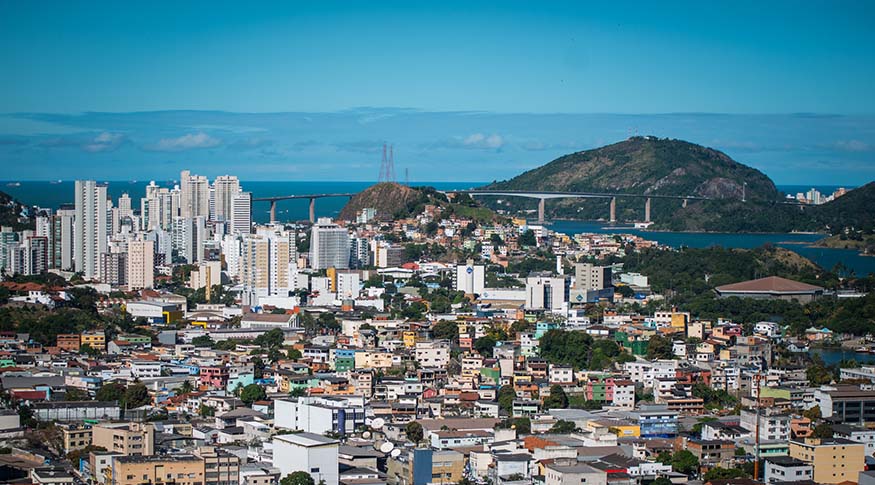UrbanRegionalDivisions
Classification of Vitória as a metropolis reduces relevance of Rio de Janeiro in the Southeast Region
December 15, 2021 10h00 AM | Last Updated: December 16, 2021 09h57 PM
Highlights
- Study identifies and delimitates urban articulate regions in the country at three levels.
- One of the three new metropolises in Brazil, according to Regic 2018, Vitória now shares with Rio de Janeiro prominence and influence in the Southeast.
- Rio de Janeiro was the area with major losses in terms of relevance in its Major Region.
- The capital of Rio de Janeiro state exerts lower influence on Espírito Santo, Bahia and Minas.
- Florianópolis and Campinas (SP), the other two metropolises, have reconfigured the urban-rural arrangement in their respective Major Regions.
- Cuiabá has also lost some relevance.
- Manaus and Recife now exert bigger influence.
One of the three new metropolises in Brazil , according to Areas of Influence of Cities (Regic 2018), released by the IBGE last year, Vitória now shares with Rio de Janeiro prominence and influence in the Southeast. That is what shows the publication Urban-Regional Division 2021, released today (15) by the IBGE, which identified and delimitated urban articulate areas in 15 metropolises and in regional capitals in Brazil. The product is also available at the Interactive Geographic Platform (PGI), where the user can combine data and download tables and maps.

With Regic 2018 as a basis, the study presents references in the country at three levels: Expanded Areas, Intermediate and Immediate Urban Articulate Areas. The classification of Vitória as a metropolis has led to concentration of the entire state of Espírito Santo under its capital. Therefore, Rio de Janeiro, which encompassed in 2013 all the intermediate areas of Espírito Santo as far as Teixeira de Freitas, south of Bahia, has had its influence reduced to within state limits. “Now that Vitória has reached the status of a metropolis, one can say Rio de Janeiro has lost relevance in the regional scenario in the current edition of this study," says Maria Monica O’Neill, survey analyst.
Rio de Janeiro now exerts lower influence on other two states: in Bahia, the Teixeira de Freitas area is now under the influence of Salvador (BA). In Minas Gerais, the area of Juiz de Fora is now under the influence of Belo Horizonte.
New metropolises also influenced the urban-regional configuration
Besides Vitória, Florianópolis and Campinas (SP) are now classified as metropolises according to Regic 2018 and have reconfigured the urban-regional scenario that encompasses neighboring regions. In the South, the three capitals now have areas of coverage that are close to the territory configuration of their respective states.
Cuiabá, one of the regional capitals identified in the study, also faced significant decrease in relevance from 2013 to 2021. The loss was due to the change in association from the intermediate area of Barra do Garças (MT) to Goiânia. The Central West is also marked by a development axis formed by Brasília, Anápolis (GO) and the capital of Goiás.
In the North Region, the highlight is the leading position of Manaus in this Major Region, since Tefé (AM) has fallen in terms of regional prominence thus leading to an increase of influence exerted by Manaus on the state. The capital can cover major distances between cities at different scales, for example, Tabatinga (AM) despite being more than one thousand kilometers far from it. The metropolis, Manaus, also exerts influence on the entire state of Roraima.
The other regional capital mentioned in the publication was Porto Velho. The capital of Rondônia has a leading position in the southern area of the North Region, with influences that go past Rondônia and reach the south of Amazonas, the west of Mato Grosso and the state of Acre. Belem engulfs almost all of Pará and the entire state of Amapá. In Tocantins, the capital Palmas is a wide intermediate area, especially in the east of the state, whereas most of the other cities were integrated to Goiânia.
In the Northeast, Fortaleza went through a considerable change, having lost Mossoró (RN) and Pau dos Ferros (RN) for Recife, but accounting for the major influence on Quixadá (CE). Recife expanded its level of influence from 2013 to 2021 and is a leading city of the northern (Rio Grande do Norte) and southern (Sergipe) boundaries of its territory.
Salvador kept its spatial coverage relatively leveled off, with some changes taking place in the west of Bahia, having reduced its influence on Santa Maria da Vitória (BA), incorporated into Brasília, but exerting influence on Luís Eduardo Magalhães (BA) and on some cities in Tocantins.
Study identifies articulate flows of the urban network
The Urban-Regional Division of Brazil provides an overall view of the country based on urban network flows. Each municipality belongs to a single region, the borders of which are not necessarily restricted to state divisions. The questionnaire was administered in 5,503 of the 5,568 municipalities in the country.
Another important characteristic of this division is the identification of a leading city for each region. The study delimitates urban articulate regions at three levels of reference, whose areas are based on a network-like structure, where territory management centers and flows define the associations and the regional arrangement.
The study subdivided the 17 extended areas (15 metropolises and two regional capitals) and 140 intermediate areas that are formed by cities with medium levels of centrality and with a population, area, number of cities and other indexes that show diversity as a distinguishing feature of Brazil. These, in turn, are divided into 379 immediate areas, cities that have, in general, connections that show accessibility and capacity to fulfill demands that are less complex and more limited in coverage. A total of 539 subcenters surrounding the immediate areas were also identified. They complement the latter in provision of goods and services and in local management functions.




















